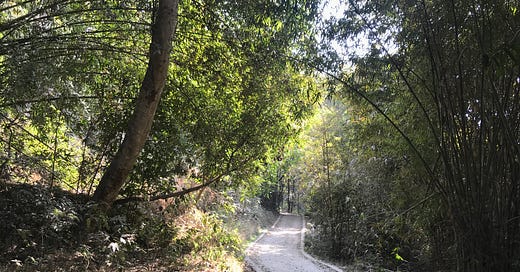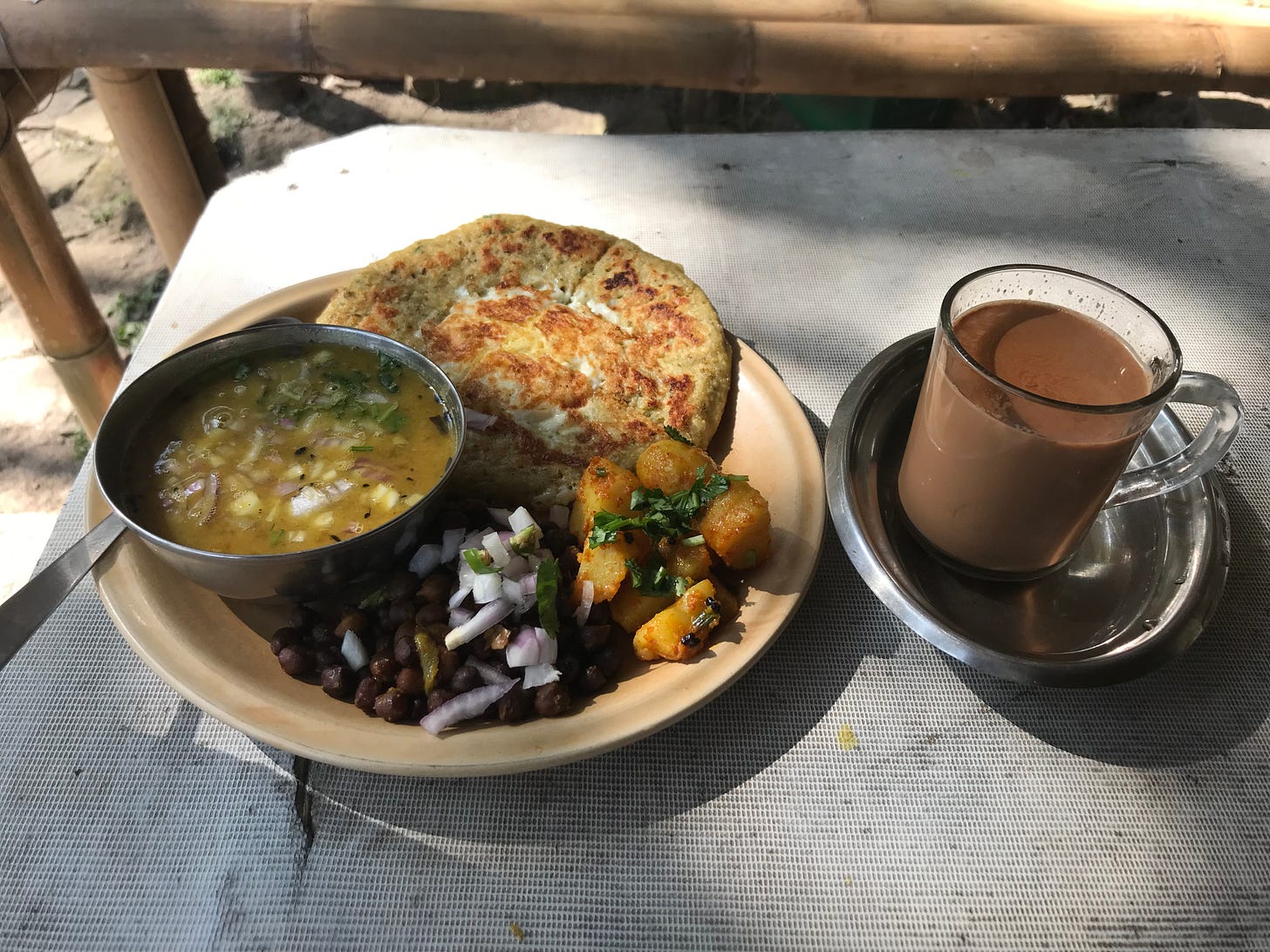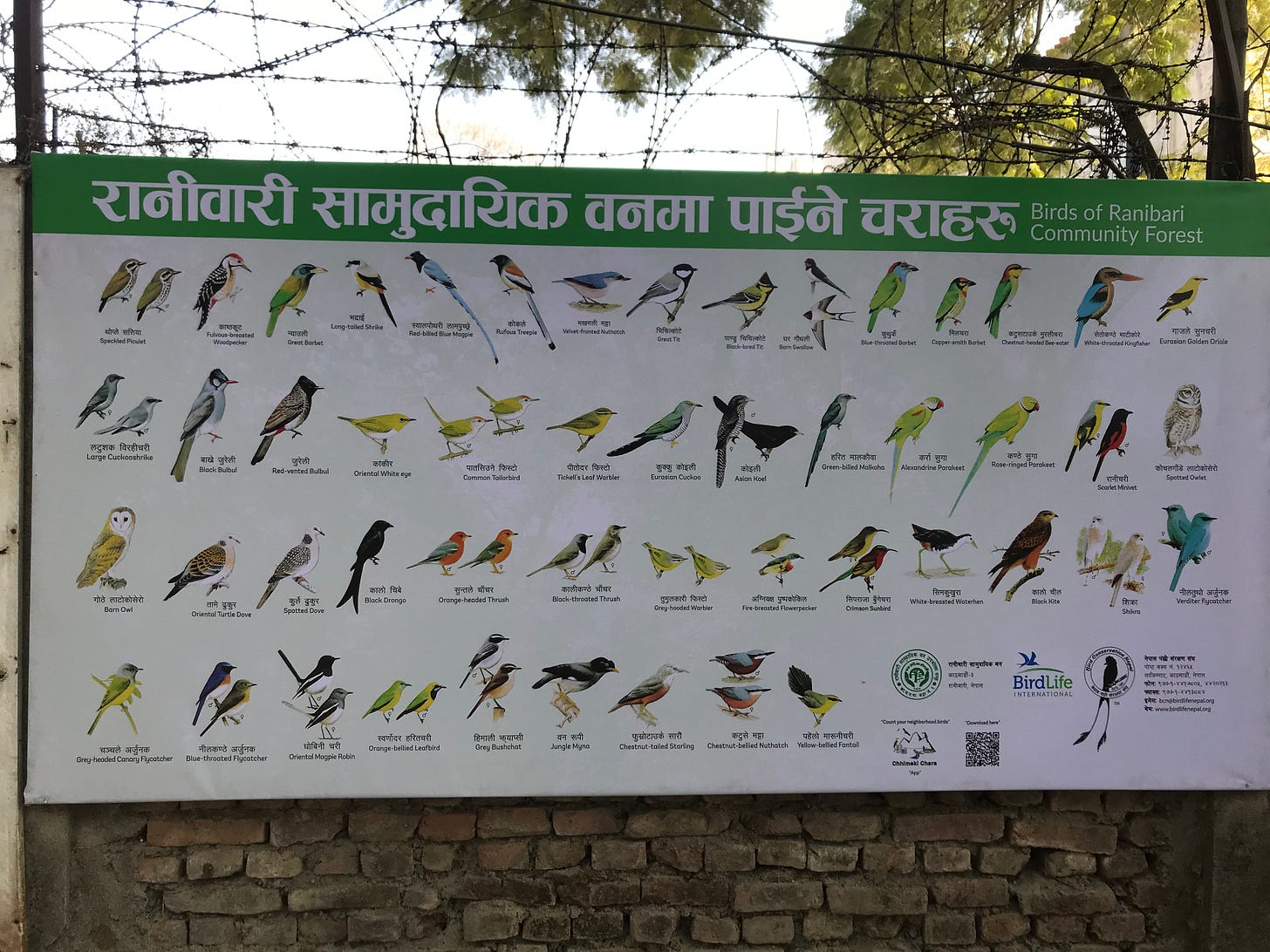When I’m not walking with a particular destination in mind—to get somewhere, that is—you might find me in Ranibari, or Queen’s Forest. This community forest is just a hair under seven hectares or 17 acres of sprawling, near-wild woodland jungle—and it’s only minutes from where I live. Nepal has many, many community forests, but this is the only one inside the Kathmandu Valley ringroad.
A winding path has been built that takes you on a lap of the whole perimeter of Ranibari, with foot-worn trails heading off of it here and there. Two stairways lead up to small hills roughly in its center.
Early morning is apparently popular for walkers, but usually by the time I arrive, it feels empty.
Not today: I pass three student couples in their college uniforms, am passed by two very serious looking runners—one of whom I recognize as a notable athlete—and see a trio laden with tripods and binoculars. These last remind me that one day I really should come here properly early in the morning with my own camera and binoculars and see if I can spot any cool birds myself.
Up the larger hill I go, past the temple atop it; two more couples sit nearby, talking quietly. As I round my circumference of the hilltop, a three-strong photo crew and their subjects, a groom in a blue suit, his bride resplendant beside him in a golden and red sari, green beads around her neck.
People watching is fun, but something I love about Ranibari is that though I saw more people today than I ever had there, when I was circling on the lower path, there might have been no-one there at all but me and a very few walkers and runners. There are vast periods of silence, and today was a warm day that didn’t feel like winter at all, the sun making patterns as it shone through the bamboo and other trees.
You can hear life going on outside, and from some parts of the track even see it, but it’s somehow muted: you are very much not there, in the bustle; you are here, in the green, the trees and birds a layer atop, even if not technically louder than, the horns and engines outside.
If you stay quiet and mostly stick to the path—less leaves to crunch—there’s wildlife here, too. Today I spotted what I believe was a shrike, some interesting scat, and surprised a small mongoose. There used to be a whole family of mongeese near my last house, not often spotted; though once, memorably, the babies came out to play and roll in the adjacent field. (Fun fact: The plural of mongoose can be both mongeese and mongooses and for some reason I love this.)
When I walked here in the rainy season, there were far less people, and on one memorable day I spotted both mongeese and, as I rounded a bend, a mammalian looking creature about the size of a medium-small dog. When I asked about it at the entrance booth, they proudly told me the forest was home to a pair of jackals. What I’d seen that day looked nothing liked the specimens I subsequently pulled up online, but until I see it again, jackal it likely was.
On my way out of the forest, I spot the little unlabeled canteen, its bamboo and corrugated sheeting structure blending in with the surroundings. Out front, some beehives, and along the little seating area, a line of plastic containers filled with barley sprouts—for juice, I was told and did I want some? I did not, but I did order chiya and inquire about food options. Eggs? Potatoes maybe? There are usually some staples small eateries, cooked and ready to serve. She rapidly listed options, then “Bara with an egg! Do you want that?” Sounded perfect.
Minutes later the tea arrived, along with a plate filled with much more food than I’d imagined I was ordering. A bara is a sort of savory pancake, made by soaking dried lentils, grinding them into a paste and frying the resulting batter. They’re often served, as this one was, with a fried egg: not on top, but cooked in—the egg is cracked on top of the raw side of the pancake while the first side is cooking. When it’s flipped, the egg cooks into the bara itself. This bara was generously large specimen. With it came cold potatoes, previously boiled and then tossed in a pan with some spices; some delicious dark spiced chickpeas served dry and topped with raw onion; and a bowl of delicious, soupy peas, sprinkled with danya and, again, the chopped onion.
It may sound simple but I tell you what: a spoon of that creamy soup with the occasional tang of biting down on a sharp, pungent raw piece of onion—it was so much more delicious than the sum of its parts and deserves much better than my simple description. Next time I visit, a bowlful of these peas and a cup of the chiya—flavorful and sweet but not overly so—will be the perfect size for a snack.
On my way out, I study the bird board by the entrance, trying to figure out what I may or may not have seen today. Then I’m back in the real world. A friend once called Ranibari’s entrance fee—ten rupees—the best value for money in the city. She’s absolutely right.






I had no idea! :)
Lovely post, makes we want to come back and explore some more ! Is this the same place we traipsed around all day looking for leopards when i was there ?